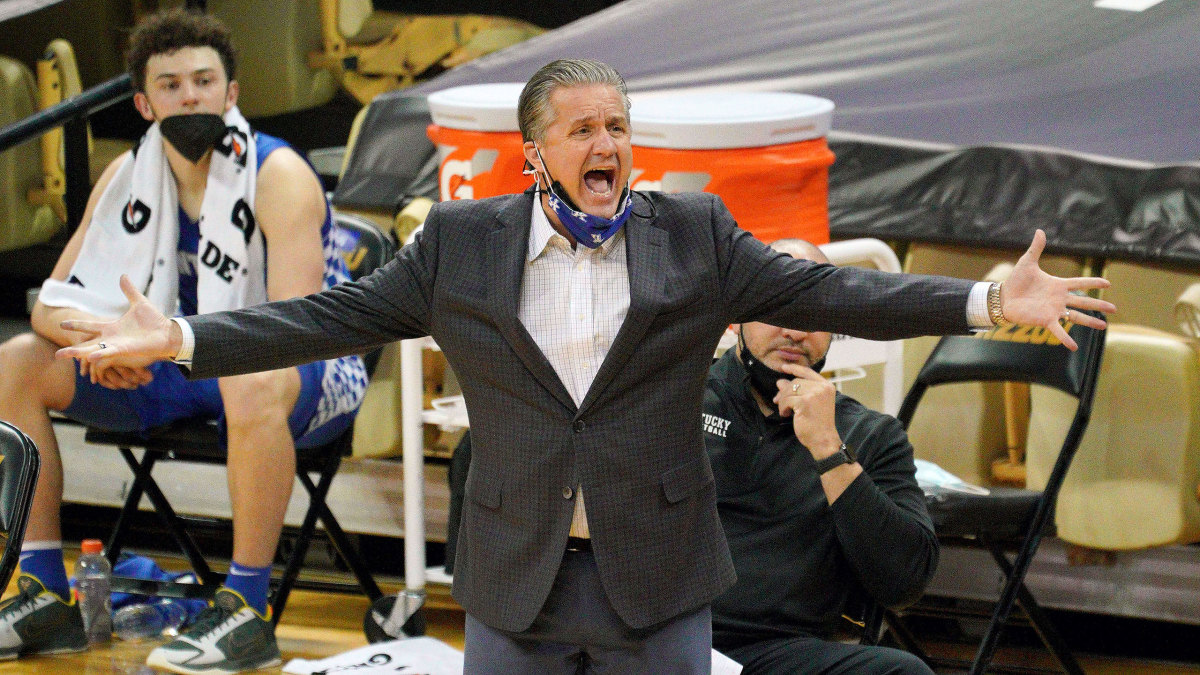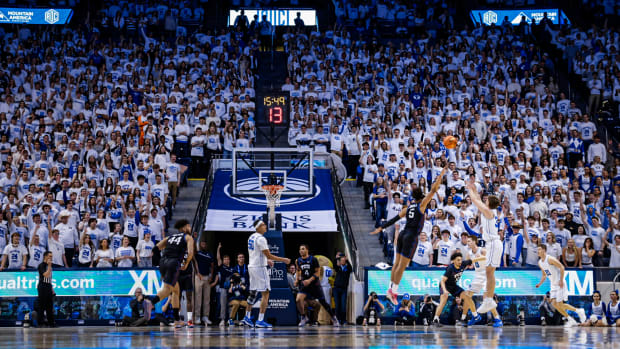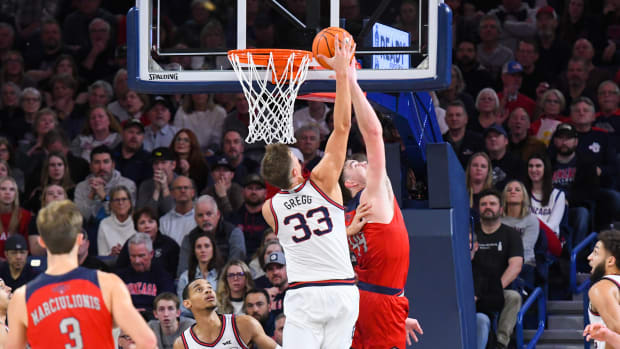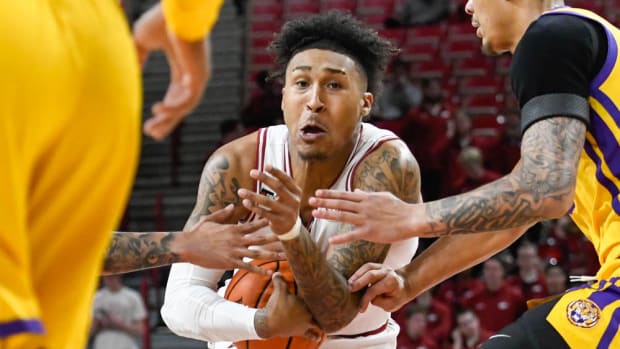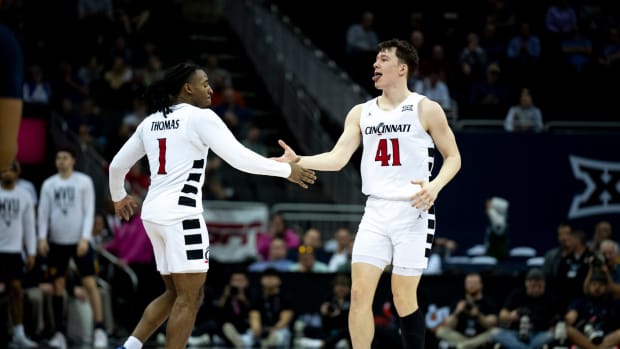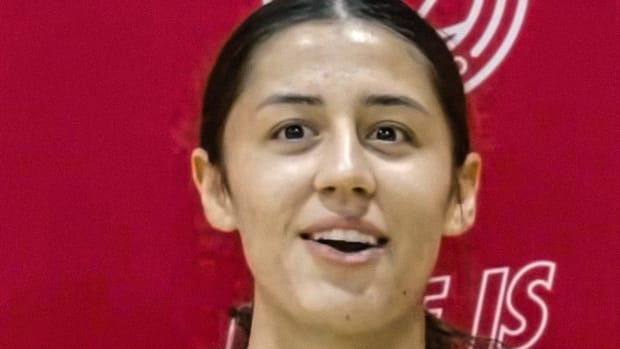Forde Minutes: Which Coaches May Be Wearing Out Their Welcome?
Forty names, games, teams and minutiae making news in men’s college basketball, where a Duke–North Carolina game at Cameron Indoor with no fans is about as sad as it gets:
IS THE RELATIONSHIP OVER?
There are a lot of coach-fan-base relationships on the rocks at the high end of the sport this season. At some schools where the love affair was in full bloom not long ago, the romance has now grown cold.
If all those places opted for divorce over couples counseling, the coaching carousel could spin through up to 20 jobs in the Power 6 conferences alone. But—stop The Minutes if you’ve heard this before—these are not normal times. Everyone already is losing millions of dollars, and divorce is costly.
So it remains to be seen whether dissatisfaction on either side of the equation, from a coach’s end or a school’s end, will result in a job change. It’s entirely possible that almost everyone will stand pat. But there is indeed dissatisfaction. After consultation with several industry insiders, The Minutes examines several situations where the thrill is gone.
TIRED
Coaches who are unlikely to be dismissed, but might be tired of the current gig and wonder whether it’s time to move on:
John Calipari (1), Kentucky. Years on the job: 12. Best of times: 2012 to ’15, when the Wildcats won a national title and advanced to two other Final Fours. Currently: This season has disintegrated into a shrill-shrieking nightmare, a 5–12 debacle spiced with repeated collapses when victory seemed to be within reach. The fans have turned on Cal, who in turn has turned on some of his players—last week he seemed to question whether Terrence Clarke is taking too long coming back from an ankle injury. (Cal could have a point; Clarke hasn’t played since Dec. 26. Cal updated Clarke's status on his radio show Monday night, saying he is expected to be out four more weeks—effectively ending his season.) Calipari also buried another freshman, Cam’ron Fletcher, six games into the season, sending him home briefly “to get his priorities in order.” Fletcher, a four-star recruit from St. Louis, has played one minute since Dec. 19. This is the worst Kentucky team since before the Great Depression, and it comes at a time when Cal’s best days in Lexington are receding further into the distance. That said, there is a 0% chance the school will fire Cal—it would cost a fortune, and his track record is too good. The issue will be whether he wants to keep going at a place where the very large, very loud fan base is questioning every single element of his coaching philosophy.
Chris Collins (2), Northwestern. Years on the job: eight. Best of times: 2016–17, when the Wildcats won 20 games in back-to-back seasons and made their first NCAA tournament in program history. Currently: Northwestern is 6–10, 3–9 in the Big Ten, riding a nine-game losing streak and on the way to a fourth straight losing season since that breakthrough bid. The backslide from reaching an all-time high point the program is mystifying, but very real. The renaissance was a blip, with no carryover. The record since ’17: 44–69, 16–54 in the league. Still, it would be a surprise to see Northwestern initiate a change: The school is searching for an athletic director to replace the outgoing Jim Phillips, on his way to become the commissioner of the Atlantic Coast Conference; it has sunk additional money into the contract of football coach Pat Fitzgerald; Collins has a young team that (if everyone sticks around) should be improved next year; and there is no discernible burning fan ambition to be successful in basketball.
Frank Martin (3), South Carolina. Years on the job: nine. Best of times: 2015–17, when the Gamecocks won 51 games across two seasons and advanced to the first Final Four in school history. Currently: South Carolina is 5–7, 3–5 in the Southeastern Conference, having played the fewest games of anyone in the league amid a COVID-19-ravaged season. The Gamecocks have remained competitive since that Final Four run, compiling a 56–52 mark and a .500 SEC record. But they haven’t gotten back to the tournament, and that won’t happen this season without a dramatic late surge. It would be a major surprise to see Martin get fired; he’s improved the product and hung that Final Four banner, and South Carolina just spent a fortune firing Will Muschamp. But at age 54, Martin theoretically has many good years left; where does he want to spend them?
(RE)TIRED?
Could these coaches decide that it’s time to hang up the whistle altogether?
Bruce Weber (4), Kansas State. Years on the job: nine. Best of times: 2018 Elite Eight run, the second of three straight NCAA bids. Currently: K-State is 5–15, 1–10 in the Big 12, stumbling toward a second straight 20-loss season. With a No. 206 ranking from Ken Pomeroy, this Kansas State team is by far the worst of any in Pomeroy’s top seven conferences. The wheels have fallen completely off in an unforgiving league. Weber has been a good fit at K-State after coming in from Illinois, and it’s hard to envision a cold firing from athletic director Gene Taylor. But at age 64, maybe he’s ready to ride off into a prairie sunset.
Jim Larrañaga (5), Miami. Years on the job: 10. Best of times: an Atlantic Coast Conference championship and Sweet 16 season in 2013, plus another Sweet 16 three years later. Currently: Miami is 7–11, 3–10 in the ACC, with the lowest Pomeroy rating of anyone in the 15-team league. This season has been hampered by injuries and missing players, but the Hurricanes are staring at a third straight losing season, something that last happened in 1991–94. Larrañaga is 71 years old; is it time to dig his toes into some South Beach sand?
Mike Brey (6), Notre Dame. Years on the job: 21. Best of times: back-to-back Elite Eights in 2015 and ’16, and an ACC tournament title in ’15. Currently: Notre Dame is 7–10 overall, 4–7 in the ACC, and trying to avoid a second losing season in the last three. The Fighting Irish haven’t been to the Big Dance since 2017. Athletic director Jack Swarbrick loves Brey, with good reason. It’s very hard to envision Swarbrick asking him to leave. And at age 61, Brey could coach quite a while longer if he wants. But he also would be a natural on TV, and might be tired of fighting some of the recruiting wars in a sport that has not sufficiently cleaned up its act after the 2017 corruption scandal.
Jim Boeheim (7), Syracuse. Years on the job: 45. Best of times: a national title in 2003, and Final Fours in 2013 and ’16. Currently: Syracuse is 10–6 overall, 4–5 in the ACC, and cannot be found in anyone’s mock brackets at present. The Orange are No. 54 in the NCAA NET rankings and have zero Quad 1 wins. Here’s the thing: Boeheim is 76 years old. His best days are behind him—but is anyone going to suggest he retire? Syracuse tried that once, and it ended with him becoming more entrenched than ever. His son, shooting guard Buddy, is a junior; perhaps when he’s done his father will go out with him.
FIRED?
The most likely candidates among the Power 6 to be dismissed by their schools:
Jim Christian (8), Boston College. Don’t cry because it’s over; smile because Christian got paid a million bucks while never going to the NCAA tournament and only once having a winning record in seven years on the job. Current record: 3–11 overall, 1–7 in the ACC.
Dave Leitao (9), DePaul. Even with a fifth consecutive last-place finish in the Big East in the works and a new athletic director, not everyone is convinced this is it for Leitao. Perhaps he’ll get a COVID-19 mulligan, since the Blue Demons didn’t even play a game until Dec. 23. But once they started playing, the product was as bad as ever.
Jim Ferry (10), Penn State. The basketball apathy runs high in State College, but not high enough to retain the interim coach who followed Pat Chambers’s October forced resignation. The Nittany Lions are 7–8, 4–7 in the Big Ten.
Steve Prohm (11), Iowa State. Wow, has this been a trainwreck season for the Cyclones. They’re 2–11, and even that incredibly bad Kansas State team mentioned above isn’t last in the Big 12; that honor goes to Prohm’s 0–8 squad. This will be Iowa State’s second losing season in a row and third in four years, at a place that had a very good run from 2012–17. Jamie Pollard may not pull the trigger amid a pandemic, but at best Prohm would be heading into a must-win season in 2021–22.
PROBABLY NOT FIRED, BUT GETTING DIRE
A change would be unexpected, but these guys are expending goodwill:
Jerry Stackhouse (12), Vanderbilt. This was a bad fit arranged by a long-gone athletic director, and the results have been brutal: Stack is 16–30 at Vandy, 4–22 in the Southeastern Conference. Two seasons would be a quick hook, so it probably won’t happen—but when the coach is firing off angry messages on Twitter at fans, it’s not a good situation. The question is whether athletic director Candice Storey Lee has the financial backing to make a second big move in a matter of months, after firing football coach Derek Mason and hiring Clark Lea.
Steve Wojciechowski (13), Marquette. He looked like the golden hire who would sustain the work of Tom Crean and Buzz Williams, but the follow-through hasn’t been there. In late February 2019, Marquette was 23–4 and ranked in the top 10. Then the Golden Eagles went flat the rest of that season and haven’t recovered. Record since then: 28–28, as a prized pair of brothers transferred. Wojo is now 9–10 in Year 7, with two NCAA appearances and no tourney wins to date.
Mike Hopkins (14), Washington. Hopkins’s change of fortune has been even more abrupt than Wojo’s. He quickly turned around the program, going 48–22 his first two seasons, winning an NCAA tourney game and bringing in some touted freshmen for 2019–20. But last year was a bust and this year was worse: The Huskies are 18–31 over that span, 7–23 in a middling Pac-12. Send help to Seattle.
Archie Miller (15), Indiana. Completing the season sweep of Iowa on Sunday should get the Hoosiers on the right side of the NCAA bubble—but nothing is forever with this program under Miller, where inconsistency has been the hallmark. If you trust the KenPom numbers, Indiana is making incremental progress under Miller: from No. 71 his first year to 52 to 34 to the current No. 25 ranking. Only thing is, Indiana traditionally has not been an incremental-success kind of program. If the Hoosiers finish this season strong, Miller would go into 2021–22 with some cushion. If not, he will be on the hot seat.
Patrick Ewing (16), Georgetown. While the Hoyas are struggling along at 5–9, two of the guards from the 2019–20 team are starring elsewhere: Mac McClung at Texas Tech and James Akinjo at Arizona. Two others are playing at different Division I schools. They’re part of the roster churn that has left Ewing without a chance to show what he can do when he has the pieces. At present, Georgetown is working on a second straight losing record and zero NCAA bids in the Ewing tenure. It seems unlikely that Georgetown will uproot the Thompson family dynasty—now or perhaps ever—but Ewing’s name recognition won’t go far in the 2020s without putting in the work on the recruiting trail.
CAUGHT ON A WIRE
Will the NCAA investigations that came out of the FBI probe of men’s college basketball finally catch up with these coaches, whose programs were implicated?
Sean Miller (17), Arizona. The Wildcats have self-imposed a postseason ban, which they termed “an acknowledgement that the NCAA's investigation revealed that certain former members of the MBB staff displayed serious lapses in judgment and a departure from the University's expectation of honest and ethical behavior.” The details of those lapses remain withheld from the public for now, though ESPN is suing the school to get access to the notice of allegations. Should this case progress to the point of a hearing and a ruling that results in sanctions against Miller, Arizona might finally have to make a move. That would create a desirable opening.
Will Wade (18), LSU. This is the last of the NCAA’s dozen cases to come out of the corruption scandal. The school has not yet received a notice of allegations pertaining to men’s basketball (it is already deep into a football infractions case that has been entwined with hoops). In April 2019, Wade agreed to an amended contract that says he can be fired for cause if he is charged with Level I or II violations. This is another instance in which the school has stood by a heavily implicated coach and essentially told the NCAA, “Catch us if you can.” We’ll see whether NCAA Enforcement can pin a major allegation to Wade.
Bill Self (19), Kansas. This case is farther down the road than the above two, although the new Complex Case Unit has drawn out the process considerably by doing some reinvestigating of what the Enforcement staff already investigated. Self is the most accomplished coach ensnared in the scandal and still has considerable support, but the allegations are major and could result in huge penalties. Would Self ride out a multiyear postseason ban? Would the school want him to?
Bruce Pearl (20), Auburn. Another school that has not divulged what it is charged with, but the allegations are significant enough that Auburn self-imposed a postseason ban for this season. Pearl is as beloved as a basketball coach can be at Auburn, taking the Tigers to their first Final Four in 2019 with an entertaining style of play. And at least among certain booster segments, there is a high tolerance for enduring scandal. Some of them will want to retain Pearl no matter what comes out of the infractions case.
Andy Enfield (21), USC. This case has flown under the radar more than any other tied to the corruption probe. USC acknowledged receiving a notice of allegations in December 2019, but did not release any details. The case is related to former assistant coach Tony Bland’s interactions with aspiring agent Christian Dawkins. Bland pleaded guilty to a felony count of conspiracy to commit bribery and was sentenced to two years probation. If USC is facing a Level I charge, which would seem likely, a postseason ban (for 2021–22) could be in play. Will Enfield face an allegation related to head coach control? That remains unknown.
THE BENEFITS OF OKLAHOMA STATE’S ENDLESS NCAA APPEAL
When his team had finally dispatched then–No. 6 Texas after two arduous overtimes Saturday, Oklahoma State coach Mike Boynton (22) threw a fist in the air in celebration. The victory was as difficult to secure as it was significant—a hard slog to a big win. “My head’s throbbing,” Boynton said afterward. “I’m exhausted.”
It was worth the effort. An Oklahoma State season that started out looking hollow, with a ban waiting at the end that would keep the Cowboys out of tournament basketball, took away much of the excitement. But an appeal of the NCAA postseason ban that the school filed June 18 still has not been heard—and that delay means Oklahoma State is virtually assured of a chance to play in the Big Dance ... if it can get in.
The school’s appeal hearing is expected to happen at the end of this week or early next week. Given the usual time frame of roughly six weeks for a ruling on that appeal, a final verdict would not be rendered before the field of 68 is announced on March 14. It seems highly unlikely that the NCAA appeal committee would fast-track a ruling that knocks a team out of the tournament just days before Selection Sunday.
Why has it taken nearly eight months for an appeal hearing to happen? Good question. The pandemic obviously has slowed down everything in the NCAA justice system, but this still seems excessive. As it stands, none of the dozen schools implicated in a bribery scandal that broke in 2017 have had a punishment applied, other than self-imposed penalties. That’s a system failure.
But you could argue that it would be unfair for Oklahoma State—a bit player in the scandal—to be the lone school to involuntarily sit out the 2021 NCAA tourney, while more involved programs are given the opportunity to chase a title. Maybe this dawdling process will be finalized before the ’22 Big Dance.
So prepare to see star freshman and potential No. 1 draft pick Cade Cunningham (23) and the rest of the Cowboys in the tournament—if they keep winning. At 12–5 overall and 5–5 in the Big 12, they’re on the right side of the bubble heading into a big game at Kansas (24) Monday night. Oklahoma State has good wins (Texas, Kansas, Oklahoma State, Arkansas) but also has been swept by TCU.
Almost every Cowboys game has been played on a razor’s edge—10 of the last 13 have been decided by five points or fewer, or gone into overtime. Which means Boynton’s head may be throbbing the rest of the way as his team tries to earn an NCAA bid that didn’t seem possible when the season began.
WHO WANTS TO BE A NO. 1 SEED?
Barring a completely unforeseen collapse, we know Baylor and Gonzaga are going to occupy half the top seed line when the NCAA tournament field is revealed. But the next two top seeds are very much up for grabs with just less than five weeks left until Selection Sunday. The leading contenders as of today:
The best team in the Big Ten (25). There are three live contenders at the moment. The leader is Michigan (13–1 overall, 8–1 in the league), but the Wolverines haven’t played since Jan. 22 and will not play until Feb. 14 at the earliest. In football, not playing wasn’t a penalty in the Big Ten—we’ll see how the basketball selection committee views it.
Behind Michigan are Illinois (13–5, 9–3) and Ohio State (15–4, 9–4). In the NCAA NET rankings, the Wolverines are third nationally, Illinois is fourth, Ohio State is seventh. Both the Illini and Buckeyes have played very well of late. Given the league’s prowess, there seems to be a high likelihood the Big Ten will get a No. 1 seed—and as of now, maybe two of them. (Iowa has played itself out of No. 1 seed contention for the time being, losing four of its last five and being swept by Indiana.)
Virginia (26). This is far from a vintage ACC, but the Cavaliers lead it with a good record (13–3 overall, 9–1 in the league) and a very good NET rating (sixth). There isn’t much on the résumé in terms of signature wins—just 2–2 in Quad 1 games—but more of those opportunities are coming up. The remaining schedule, while certainly fluid, features a home game against North Carolina and road trips to Florida State, Duke and Louisville.
Alabama (27). The Minutes would endorse a second Big Ten team over the Crimson Tide, which has not passed the look test of late in losses to short-handed Oklahoma and Missouri. But give Bama (15–5, 10–1 in the SEC) this: Its only league loss was by three points on the road against a ranked opponent. Yes, the Tide trailed the whole game at Missouri on Saturday, by as many as 22 points, but had the ball with a chance to win late and couldn’t convert. The Tide could be favored in every remaining regular-season game, and a 22–5, 17–1 mark would look pretty strong.
Villanova (28). This modestly athletic team is by no means one of Jay Wright’s best, but the Wildcats are 12–2 and 7–1 in the Big East, with a No. 11 NET rating. The league isn’t great, which could cost Nova in a résumé contest with others in contention for a top seed, but two remaining games with Creighton will add some heft to the body of work.
(Houston isn’t on the list after losing to AAC last-place team East Carolina last week.)
ROBERT MORRIS’S SEASON OF DRAMA
Over the weekend, Robert Morris (29) twice made buzzer-beating shots against Youngstown State. And lost both games.
The Colonials, playing their first season in the Horizon League after stepping up from the low-major Northeast Conference, have cornered the conference market on dramatic heartbreak. On Friday night, guard Jon Williams hit a three-pointer as time expired to send the game into overtime, whereupon the Penguins pulled away to win by six. On Saturday afternoon, Cameron Wilbon connected on a floater with a second left to put the game into OT, whereupon Youngstown again got the victory, 70–66.
"Is anybody feeling a bad case of déjà vu here or what?" asked Andy Toole after the second OT loss in less than 24 hours.
It was the fourth overtime game of the season for Robert Morris, which has lost them all. On Jan. 23, the Colonials gave up the game-tying layup to Northern Kentucky with four seconds left and then lost in OT. On Jan 16 against Illinois-Chicago, there was a single point scored by the two teams in the final 1:50 of regulation and no points scored in the final minute. UIC won that one in the extra session.
"We talk a lot that there's two ways to learn," Toole says. "The easy way and the hard way. We've certainly embraced the hard way right now.”
Robert Morris takes an eight-game losing streak into its Friday-Saturday home games against Oakland. For what it’s worth, the school record for overtime games in a season is five.
FIVE QUESTIONS (AND ONE) WITH A COACH
Each week, The Minutes will ask a coach five questions, then give that coach an opportunity to ask a question of their own. In this installment, The Minutes caught up with Loyola Chicago coach Porter Moser (30) late last week, before the Ramblers swept Evansville to run their winning streak to 10 games. His current 17–3 Loyola team bears some resemblance to the Cinderella squad that made the 2018 Final Four.
With Drake’s loss to Valparaiso, the two teams are tied in the loss column atop the Missouri Valley Conference heading into a showdown weekend in Des Moines.
Question 1: The Valley has been playing back-to-back games against the same opponent this season. What’s that dynamic been like?
Moser: “It’s tough to play the same team twice in a row. There’s two challenges the second night: if you win, the challenge is to have the foot on the gas pedal and not be overly satisfied; if you lose, how do you bounce back? The second night has been all about attitude, mindset and toughness (31).”
Question 2: The winning culture established by that 2017–18 team has carried on with what should now be a fourth straight 20-win season. How has that happened?
Moser: “Culture carryover is all about the upperclassmen (32). It’s what you want in a program, and that’s how you sustain it. When the Final Four seniors were freshmen, they were part of a CBI championship team. They carried that forward. Now we have seniors Cameron Krutwig and Lucas Williamson, who were freshmen on the Final Four team, and they’re protecting that culture. That’s what’s fun as a coach, is seeing the older players fighting to protect that culture.”
Question 3: How do you describe Krutwig? [The 6' 9" 255-pounder recently became one of four players in Missouri Valley history to record more than 1,500 points, 800 rebounds and 300 assists in his career. The other three: Oscar Robertson, Larry Bird and Hersey Hawkins.]
Moser: “He has such an old-school game. He’s an old soul. Krutwig is always the guy in the back of the bus getting everyone going. One trip he was back there and he busts out singing [1960s and ’70s crooner] Tom Jones. He doesn’t pass the eye test, and thankfully he didn’t in AAU. But you watch him and you understand, that is a true basketball player, through and through. His enthusiasm and communication is like a 5' 10" walk-on guard (33).”
Question 4: How is Sister Jean [now 101 years old] making it through the pandemic?
Moser: “She’s under triple, quadruple security (laughs). We are making sure she is safe. But she still prays with us (34)—we will FaceTime her before a game when we get in our [prayer] circle. And I’ll usually have an email 30 minutes after the game with her thoughts.”
Question 5: What’s been the hardest part of a COVID-19 season?
Moser: “The earlier months, not being with them face-to-face when we’re going through the social justice issues, was the hardest part. You’ve got to have these discussions over Zoom. I hated that (35). I wanted to be with them, to talk to them in person.”
And Moser’s question for The Minutes: I’m from Chicago. When you come here, what five things are on your bucket list?
Minutes: “Lake Michigan. I’d say the Sears Tower, but you can’t go up in that—make that the Hancock Building. The Magnificent Mile. NOT a Cubs game—I’m a Cardinals fan, so I’m going to see the White Sox over the Cubs. And the Billy Goat Tavern.”
[The snubbing of the Cubs was not met with approval.]
Moser: “What do we need to do to get you to a Rambler game?”
Minutes: “Let’s make it happen.”
STAT OF THE WEEK—AAC SCHEDULES FROM HELL
Like many other leagues, the American Athletic Conference is juggling chainsaws this month, trying to reschedule games and get in as many as possible. Some of what the conference has come up with is going to be rough.
Consider UCF (36), currently scheduled to play 10 games in February. That includes trips to Memphis, Tulsa, Cincinnati, New Orleans and Dallas.
And consider Tulane (37), scheduled to play four road games from Feb. 10 to 17: Tulsa, UCF, South Florida, SMU. The Green Wave are playing seven road games in the month of February.
Those teams are ninth and 11th, respectively, in the AAC. Don’t expect them to rise much, if at all, while working through this February gantlet.
COACH WHO EARNED HIS COMP CAR THIS WEEK
Cuonzo Martin (38), Missouri. The Tigers had to white-knuckle their way through near-collapses against Kentucky and Alabama last week—but they did it, completing the program’s best week since joining the SEC in 2012–13. This is a bad Kentucky team, but Missouri’s record against the Wildcats before last week was 1–13. And the Crimson Tide were running away with the conference race until Mizzou threw the brakes on Bama. In his fourth year, Martin has a veteran team that is capable of stretches of brilliance at both ends of the floor. Mizzou is well on its way to its highest seeding since being a No. 2 in 2012.
COACH WHO SHOULD TAKE THE BUS TO WORK
Fran McCaffery (39), Iowa. The schedule is brutal, and the Hawkeyes have missed injured sharpshooter C.J. Fredrick. But losing four of five has folks in Iowa City on high alert for another late-season fade. This Iowa team is capable of great things in March—if it doesn’t fall apart in February.
BUZZER BEATER
When hungry in The Minutes’s home base of Louisville, order up some wings from Bootleg Barb-B-Q (40). They sold out for Super Bowl Sunday for a reason. Pair them with a local product from Great Flood Brewery and thank The Minutes later.
